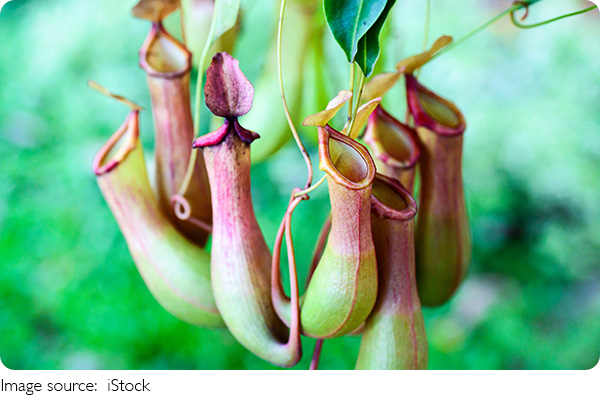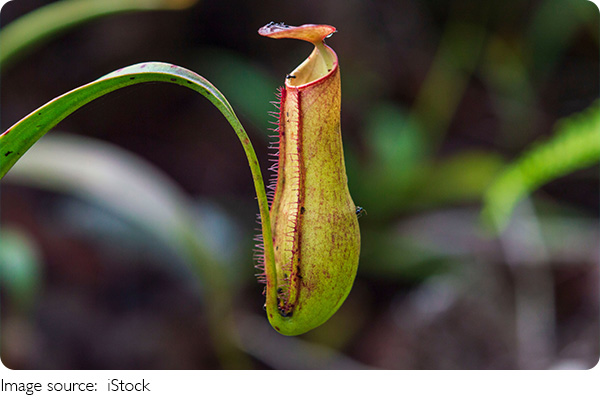Insect-Eating Plants

When we think of plants, we usually picture them soaking up sunlight, drinking water, and growing quietly. But some plants play a very different game—they trap and digest insects.
Yes, some plants actually "eat" bugs! But why do they do this? Let's explore the clever reasons behind this strange yet fascinating behavior.
It's About Getting Nutrients
Most plants absorb the nutrients they need—like nitrogen, phosphorus, and potassium—from the soil. But some plants grow in places where the soil is very poor, such as bogs, swamps, or sandy areas. In these places, there just isn't enough nutrition in the ground.
So what do these plants do? They adapt. Instead of relying only on the soil, they start getting nutrients in a different way—by catching and breaking down insects. These bugs provide the minerals that the soil can't.
How Do Carnivorous Plants Catch Insects?
Different plants use different strategies to catch their prey. Let's take a look at some famous bug-eating plants and how they work:
• Venus Flytrap: This plant has two “jaw-like” leaves with tiny hairs. When an insect touches the hairs twice, the trap snaps shut—like a green mouth! It then slowly digests the insect.
• Pitcher Plant: It has deep, cup-shaped leaves filled with liquid. Bugs slide in, can't climb out, and get digested in the fluid at the bottom.
• Sundew: This plant has sticky tentacles on its leaves. When a bug lands on them, it gets stuck. The sundew then curls around the insect and breaks it down with digestive juices.
• Butterwort: It looks like an innocent leafy plant, but its surface is sticky and slippery. Once a small insect lands, it can't escape.
Each of these methods shows how smart nature can be when survival is on the line.
They Still Need Sunlight
Even though they eat insects, these plants still do photosynthesis like regular plants. They need sunlight to make energy, just like flowers and trees. The insects are more like a nutritional supplement than a full meal.
So while it may look like they're eating bugs for fun, they're really just trying to stay healthy in a difficult environment.
Where Can We Find Them?
Carnivorous plants are found all over the world, but they mostly grow in places where the soil is low in nutrients. Some common spots include:
• Wetlands and bogs
• Tropical rainforests
• Sandy or acidic soil areas
We can even grow some of these plants at home, as long as we give them the right conditions—humid air, clean water, and mineral-poor soil.
Are These Plants Dangerous?
Not to us! Carnivorous plants don't eat large animals or humans. Their traps are made for tiny insects. They're safe to keep as houseplants and can even help reduce the number of gnats or fruit flies in your home.
They're more fascinating than frightening—and they show us how plants can adapt in ways we never expect.
What Can We Learn from Them?
Carnivorous plants teach us that life finds a way—even when conditions are tough. They've turned what seems like a weakness (poor soil) into an opportunity (bug-catching).
Their designs also inspire scientists and engineers. For example, the fast snap of a Venus flytrap has influenced research into smart sensors and motion-triggered devices.

Let's Explore More Together
Next time you see a Venus flytrap or pitcher plant, take a closer look. Behind their quiet appearance is a survival story full of creativity and adaptation.
Have you ever grown a carnivorous plant at home? Or seen one in the wild? Tell us your favorite bug-eating plant—we'd love to know which one amazed you the most!
-
 Sesame Growth TruthHow Does Sesame Grow? The Real Plant Might Surprise You With Its Growth Pattern!
Sesame Growth TruthHow Does Sesame Grow? The Real Plant Might Surprise You With Its Growth Pattern! -
 Sun and SucculentsDoes more sunlight really make succulents turn red? Let's explore the science behind this fascinating phenomenon.
Sun and SucculentsDoes more sunlight really make succulents turn red? Let's explore the science behind this fascinating phenomenon. -
 Desert Plant HeroesYou Won’t Believe How Giant Cacti Survive, Bloom, and Thrive in the Scorching Desert for Over 200 Years!
Desert Plant HeroesYou Won’t Believe How Giant Cacti Survive, Bloom, and Thrive in the Scorching Desert for Over 200 Years!